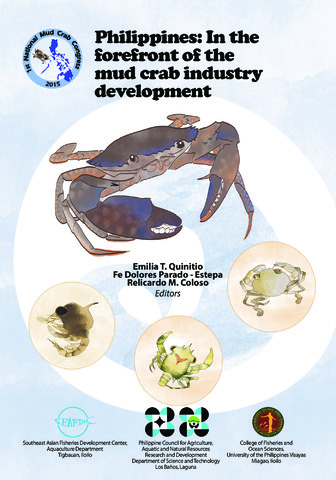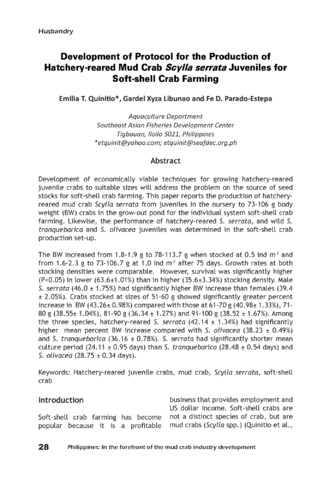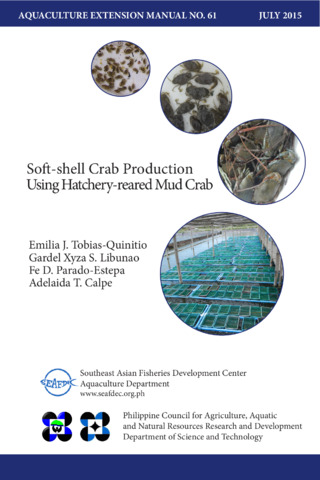Monosex culture of the mud crab Scylla serrata at three stocking densities with Gracilaria as crab shelter
Share
| dc.contributor.author | Triño, Avelino T. | |
| dc.contributor.author | Millamena, Oseni M. | |
| dc.contributor.author | Keenan, Clive P. | |
| dc.contributor.editor | Keenan, Clive P. | |
| dc.contributor.editor | Blackshaw, Alan | |
| dc.date.accessioned | 2011-06-22T09:35:46Z | |
| dc.date.available | 2011-06-22T09:35:46Z | |
| dc.date.issued | 1999 | |
| dc.identifier.citation | Triño, A. T., Millamena, O. M. & Keenan, C. P. (1999). Monosex culture of the mud crab Scylla serrata at three stocking densities with Gracilaria as crab shelter. In C. P. Keenan & A. Blackshaw. (Eds.). Mud Crab Aquaculture and Biology. Proceedings of an international scientific forum held in Darwin, Australia, 21–24 April 1997 (pp. 61-66). Canberra: Australian Centre for International Agricultural Research. | en |
| dc.identifier.uri | http://hdl.handle.net/10862/430 | |
| dc.description.abstract | The effects of three levels of stocking density (0.5, 1.5 or 3.0/m2) and monosex culture (male or female) on the growth, survival and production of Scylla serrata were investigated. Juvenile crabs were stocked in 150 m2 enclosures in earthen ponds with Gracilaria as shelter and fed a mixed diet of 75% fresh brown mussel flesh and 25% fish bycatch. There was no interaction between stocking density levels and monosex culture (P<0.05) so the data were pooled for each sex or stocking density treatment. Results showed that highest survival was obtained from a stocking density of 0.5/m2 (P<0.05). Crab growth at different stocking densities was not significantly different (P>0.05). Highest return on investment (ROI) and lowest production costs were attained from 0.5/m2. Partial budgeting analysis showed that no net benefit accrued from stocking beyond 1.5/m2. Male crabs attained significantly better (P<0.05) final weight and specific growth rate than female crabs. Length, width, survival and production between male and female crabs were not significantly different (P>0.05). Male and female monoculture gave high net revenue and ROI of more than 100 but male monoculture is more profitable. Overall the results suggest that the culture of male or female mud crabs at 0.5–1.5/m2 with Gracilaria is economically viable. | en |
| dc.language.iso | en | en |
| dc.publisher | Australian Centre for International Agricultural Research | en |
| dc.subject | Crustacea | en |
| dc.subject | Mud crab culture | en |
| dc.subject | Shelters | en |
| dc.subject | Monosex culture | en |
| dc.subject | Stocking density | en |
| dc.subject | Philippines | en |
| dc.subject | Crabs | en |
| dc.subject | Mud crab | en |
| dc.subject | Seaweeds | en |
| dc.subject | Scylla serrata | |
| dc.subject | Gracilaria | |
| dc.subject.lcc | VF SP 234 | |
| dc.title | Monosex culture of the mud crab Scylla serrata at three stocking densities with Gracilaria as crab shelter | en |
| dc.type | Conference paper | en |
| dc.citation.spage | 61 | |
| dc.citation.epage | 66 | |
| dc.citation.conferenceTitle | Mud Crab Aquaculture and Biology. Proceedings of an International Scientific Forum, 21-24 April 1997, Darwin, Australia | en |
Files in this item
| Files | Size | Format | View |
|---|
This item appears in the following Collection(s)
-
AQD Conference Proceedings [298]
These papers were contributed by AQD staff to various national and international Conferences



